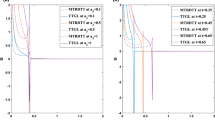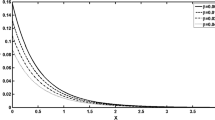Summary
The linear theory of thermoelasticity without energy dissipation is employed to study thermoelastic interactions due to a continuous line source of heat in a homogeneous and isotropic unbounded solid. Laplace and Hankel transforms are employed to solve the problem. Exact expressions, in closed form, for the temperature and stress fields are obtained. Numerical results for a hypothetical, copper-like material are presented with the view of illustrating the theoretical results.
Similar content being viewed by others
References
Chadwick, P.: Thermoelasticity, the dynamic theory. In: Progress in solid mechanics, vol. I (Sneddon, I. N., Hill, R., eds.), p. 265. Amsterdam: North-Holland 1960.
Lord, H. W., Shulman, Y.: A generalized dynamical theory of thermoelasticity. J. Mech. Phys. Solids15, 299–309 (1967).
Green, A. E., Lindsay, K. A.: Thermoelasticity. J. Elasticity2, 1–7 (1972).
Chandrasekharaiah, D. S.: Thermoelasticity with second sound: a review. Appl. Mech. Rev.39, 355–376 (1986).
Ignaczak, J.: Generalized thermoelasticity and its applications. In: Thermal stresses, vol. III (Hetnarski, R. B., ed.), Chapter 4. Oxford: Elsevier 1989.
Joseph, D. D., Preziosi, L.: Heat waves. Rev. Mod. Phys.61, 41–73 (1989) and addendum62, 375–391 (1990).
Green, A. E., Naghdi, P. M.: Thermoelasticity without energy dissipation. J. Elasticity31, 189–208 (1993).
Chandrasekharaiah, D. S.: A uniqueness theorem in the theory of thermoelasticity without energy dissipation. J. Thermal Stresses19, 267–272 (1996).
Chandrasekharaiah, D. S.: A note on the uniqueness of solution in the linear theory of thermoelasticity without energy dissipation. J. Elasticity43, 279–283 (1996).
Chandrasekharaiah, D. S.: One-dimensional wave propagation in the linear theory of thermoelasticity without energy dissipation. J. Thermal Stresses19, 695–710 (1996).
Chandrasekharaiah, D. S.: Thermoelastic plane waves without energy dissipation. Mech. Res. Comm.23, 549–555 (1996).
Chandrasekharaiah, D. S., Srinath, K. S.: One-dimensional waves in a thermoelastic half-space without energy dissipation. Int. J. Eng. Sci.34, 1447–1455 (1996).
Sherief, H. H., Anwar, M. N.: Problem in generalized thermoelasticity. J. Thermal Stresses9, 165–181 (1986).
Chandrasekharaiah, D. S., Murthy, H. N.: Temperature-rate-dependent thermoelastic interactions due to a line heat source. Acta Mech.89, 1–12 (1991).
Ezzat, M. A.: Fundamental solution in thermoelasticity with two relaxation times for cylindrical regions. Int. J. Eng. Sci.33, 2011–2020 (1995).
Erdelyi, A. (ed.) Table of integral transforms, vol. I., p. 277. New York: McGraw-Hill 1954.
Green, A. E., Naghdi, P. M.: A re-examination of the basic postulates of thermomechanics. Proc. R. Soc. London Ser. A432, 171–194 (1991).
Green, A. E., Naghdi, P. M.: On undamped heat waves in an elastic solid. J. Thermal Stresses15, 253–262 (1992).
Author information
Authors and Affiliations
Rights and permissions
About this article
Cite this article
Chandrasekharaiah, D.S., Srinath, K.S. Thermoelastic interactions without energy dissipation due to a line heat source. Acta Mechanica 128, 243–251 (1998). https://doi.org/10.1007/BF01251894
Received:
Revised:
Issue Date:
DOI: https://doi.org/10.1007/BF01251894




